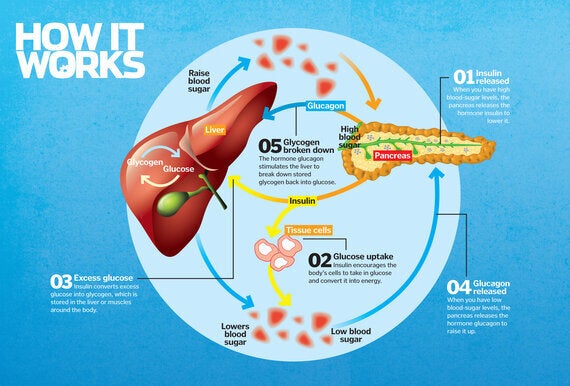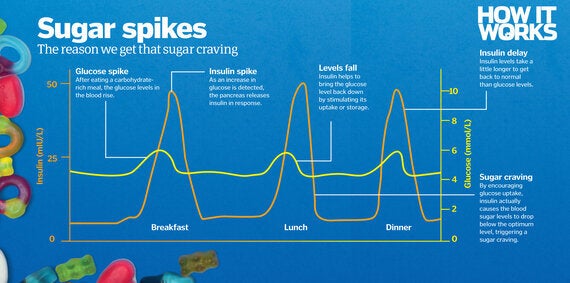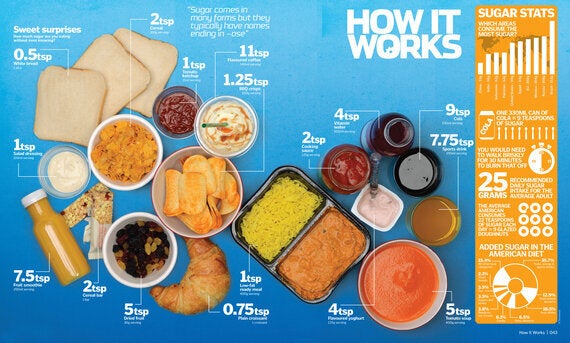After last week's headlines about the shocking amount of sugar found in coffee-shop beverages, I thought it might be a good time to share an article that appeared in a recent issue of How It Works magazine which explained some of the science behind sugar including where it comes from, where it might be hiding and the effects it can have on our bodies if consumed in excess.
It's true that many of us are overindulging in the white stuff, with the average adult consuming approximately 63 grams (2.2 ounces), nearly 16 teaspoons, of sugar each day. That's over twice the recommended daily intake. The main attraction to sugar, for both humans and animals, is its sweet taste. In nature, this is a useful indication of which foods are safe to eat, as poisonous fruits and plants tend to be sour or bitter, but in the modern world of processed foods and fizzy drinks, sweetness is mainly associated with pleasure. As a result, sugar is added to many of the foods we consume each day to artificially boost the flavour or texture, or act as a preservative by hindering the growth of bacteria. This may be good news for our taste buds, but it's not so good for our health.
By eating more sugar than our bodies actually need, we are storing the excess as fat, leading to an increase in obesity and many other health problems throughout the world. Keeping track of how much sugar we eat can be difficult, though, as it goes by many different names and is hidden in some unlikely foods. Plus, not all sugars are bad, but working out which ones are good can be a challenge.
Where sugar comes from
The white stuff we know as sugar is sucrose, a carbohydrate made up of two other sugar molecules, glucose and fructose, linked together. Sucrose is present in most plants, but the highest concentrations can be found in sugarcane and sugar beets, which is why these crops are the main source of commercial sugar production across the world. Sugarcane was the original sugar plant and is now the source for 75 per cent of the world's sugar needs. Sugar beet was originally grown as a garden vegetable, until its sugar content was realised around 1747. Today, it makes up the remaining 25 per cent of the world's sugar supply.
Sugar in the body
When we digest sugar, enzymes in the small intestine break it down into glucose. This glucose is then released into the bloodstream, where it is transported to tissue cells in our muscles and organs and converted into energy. Beta cells in the pancreas constantly monitor the amount of glucose in the bloodstream and release insulin to control it. This means that if you consume more sugar than your body needs right away, it can be stored for later to keep your blood-sugar levels constant. If your body stops producing any or enough insulin, or if your cells become resistant to it, this can result in diabetes, leaving your blood-sugar levels to rise to dangerous levels.
Keeping blood sugar in check
The hormones that keep our energy levels constant

Sugar on the brain
As humans, we are programmed to love sugar. Our primate ancestors evolved to seek out sweet foods for their high-energy content to increase their chance of survival when food was scarce. Nowadays food is much more readily available, yet we still can't get enough of the sweet stuff. The reason for this is all in the brain. When we eat sugar, the brain releases dopamine and serotonin, the hormones that boost your mood, which then stimulate the nucleus accumbens - the area of the brain associated with reward. This is a similar process that leads to drug addiction, which is why we get those sugar cravings. Regular sugar consumption can also inhibit dopamine transporters, which can lead to you needing to eat even more sugar to get the same pleasure reward as before. In addition, fructose, which is used to sweeten many foods and drinks, doesn't suppress hunger hormones like glucose does, meaning your body is unable to tell when you've eaten enough.

Too much sugar
What happens to your body when you overindulge your sweet tooth? Sugar is essential for the human body as it powers the cells that keep us alive. However, eating too much of it can also have a negative effect on our health. Foods with added sugar that does not occur naturally contain empty calories, meaning that they have no other benefit than to provide energy. If we eat more sugar than our energy levels require, then our bodies have to find something else to do with it, creating a whole host of problems. Excessive sugar consumption is one of the leading causes of obesity, heart disease and diabetes.

Where is sugar hiding?
The high sugar content of foods such as sweets, chocolate, cakes and fizzy drinks is well known, but some foods we generally consider as 'healthy' and not particularly sweet also have a surprising amount of sugar in them. Sugar comes in many forms but they typically have names ending in -ose. As well as glucose and fructose naturally found in fruit, vegetables and honey, lactose and galactose can be found in milk and dairy products, and maltose in barley. These natural sugars are fine in moderation as they also come with other nutritional benefits. For example, a piece of fruit will also contain fibre, which helps limit the amount of fructose the body absorbs. Added sugar, used to improve the taste and textures of foods and drinks, is the type that is considered unhealthy. This usually comes in the form of sucrose, or as a sugar substitute such as sucralose, saccharin, aspartame or high-fructose corn syrup (HFCS). HFCS is artificially produced from corn and used in many processed foods and fizzy drinks. To find out how much sugar is in your food, check the 'carbohydrates - of which sugars' value on the label.

This article appears in full in How It Works issue 73. How It Works is the magazine that feeds minds and aims to inspire a sense of awe and wonder at the world we live in.